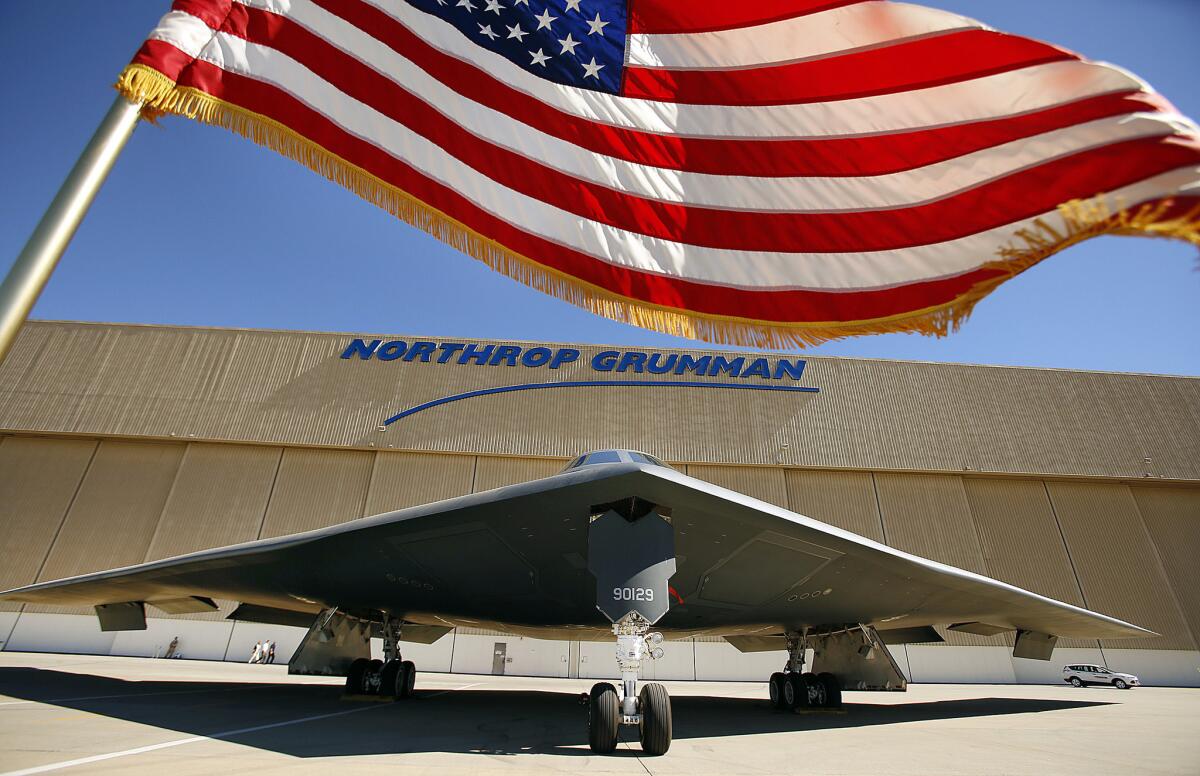Northrop’s deal to build new stealth bomber may create thousands of jobs in Southland

A B-2 Spirit Stealth bomber taxis to the runway at the Northrop Grumman Corp. facility in Palmdale in 2014. Northrop will build 80 to 100 new strategic bombers over the next decade.
- Share via
Aerospace giant Northrop Grumman Corp. won an intense four-year competition Tuesday to build the nation’s new fleet of stealth bombers, a project likely to create thousands of jobs in Southern California.
In an announcement at the Pentagon that took industry experts by surprise, the Air Force said Northrop had beaten a team from Boeing Co. and Lockheed Martin Corp. to build 80 to 100 long-range bombers over the next decade.
The project’s cost could eventually exceed $80 billion, making it one of the most expensive in the Pentagon’s history.
SIGN UP for the free California Inc. business newsletter >>
“Our team has the resources in place to execute this important program,” said Wes Bush, Northrop’s chairman, “and we’re ready to get to work.”
In the months leading up to the highly anticipated decision, Northrop had told local government officials that it planned to build much of the plane at the sprawling complex of hangars and runways in Palmdale known as Air Force Plant 42.
The company had said the contract could mean 1,400 new jobs at its Palmdale facility, which it leases from the military.
“We’re very excited,” Palmdale Mayor Jim Ledford said of the Pentagon’s decision. “Aerospace is what we do, and what we’ll continue to do.”
Two decades ago, Northrop built the bat-winged B-2 stealth bomber at the same site in the Mojave Desert about 70 miles northeast of downtown Los Angeles.
Northrop said little Tuesday about its plans other than releasing a short written statement from Bush.
But Rep. Steve Knight, a Republican who represents the Antelope Valley, said that a top Northrop executive had told him earlier that the plane “would be rolling out in Palmdale.”
Last year, Knight wrote a bill when he was a state legislator that will give Northrop, headquartered in Falls Church, Va., a tax credit of up to nearly $500 million in return for performing much of the work in Palmdale. Legislators gave Lockheed a similar tax incentive.
Northrop was seen as the underdog in the battle for the contract, fighting against the Boeing-Lockheed team that was considered better funded and more politically connected.
Analysts said Tuesday that they expect Boeing and Lockheed to challenge the decision.
On Tuesday, executives at the two rivals said they were disappointed. In a joint release, the companies said they were talking to the Air Force “before determining our next steps.”
Little is known about the new stealth bomber. Details are shrouded in secrecy. There is no word on what the as-yet unnamed bomber will look like or how fast and high it will fly.
Both teams had drawn up plans for the bomber under classified contracts in the Pentagon’s so-called black budget.
Military officials have said the new bomber would eventually be equipped to fly nuclear weapons. The plane may also someday have the capability to fly as a drone.
The Pentagon says it needs the new warplane to replace its aging fleet of B-1 bombers, which were designed in the 1970s, and even older B-52s.
“Today, it’s vital to innovate and reinvest in the people, strategies and technologies that will allow America’s military to be dominant in the second aerospace century,” Defense Secretary Ashton Carter said Tuesday as the contract was announced.
The contract has two parts. In the first phase, Northrop will receive more than $20 billion to develop the bomber.
The company would then be paid $550 million to build each plane — an award that could reach $60 billion.
Critics say the cost of the contract is bound to skyrocket, similar to what happened when Northrop built the B-2 bomber in the 1980s.
That contract was so far over budget that the Pentagon decided to build just 21 of the 132 aircraft it had originally planned. The average cost of each B-2 soared to more than $2 billion.
Many experts also question why the Pentagon even needs a new bomber. The Air Force is already spending billions of dollars to modernize its current fleet of 150 bombers, readying them for the next 25 to 50 years.
But such skepticism is hard to find in the Antelope Valley, which still hasn’t fully recovered from the 2008 financial crisis.
Both Palmdale and the neighboring city of Lancaster have suffered in the last couple of decades as aerospace firms moved jobs out of California to states where wages and other costs are lower.
Robert Kleinhenz, chief economist of the Los Angeles County Economic Development Corp., said the county currently has about 38,000 aerospace jobs — about 8% of the nation’s total.
That is down 70% from 25 years ago when the county had 130,000 aerospace jobs, or more than 15% of the nation’s total.
The bomber contract could increase jobs across Southern California, Kleinhenz said, especially benefiting dozens of smaller companies that supply the major aerospace firms.
Said Lancaster Mayor R. Rex Parris of the contract announcement: “This is probably the best news Lancaster has received since I’ve been here. It will be restorative.”
ALSO:
Walgreens to buy rival Rite Aid for $9.4 billion, creating drugstore giant
China’s Studio City, a Hollywood-themed casino-resort, opens in Macau
Interactive map gives muggles a peek into Harry Potter attraction
More to Read
Sign up for Essential California
The most important California stories and recommendations in your inbox every morning.
You may occasionally receive promotional content from the Los Angeles Times.












